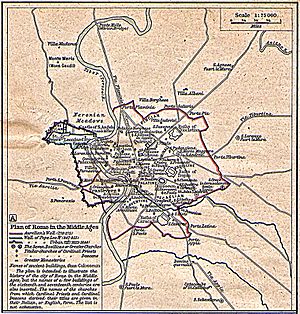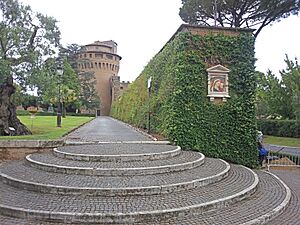Leonine City facts for kids
The Leonine City (in Latin: Civitas Leonina) was a special part of Rome during the Middle Ages. It was surrounded by a strong wall called the Leonine Wall. Pope Leo IV ordered this wall to be built in the 800s.
This area was on the other side of the Tiber River from Rome's famous Seven Hills. It wasn't protected by Rome's older Aurelian Walls. As Christianity grew and the Western Roman Empire ended, this area needed new defenses. This was because it was home to St. Peter's Basilica, a very important church.
Today, the land that was once the Leonine City is now Vatican City State. It also includes the Roman neighborhood, or rione, called Borgo.
Contents
Building the Leonine Wall: A Story of Protection
The Leonine Wall was built by Pope Leo IV. This happened after Muslim raiders attacked and robbed Old St. Peter's Basilica in 846. The wall was built from 848 to 852. It was the only time Rome's city walls were ever made bigger.
This new wall completely surrounded the Vatican Hill for the first time. Another Pope, Leo III, had tried to start building it earlier. But problems in the city stopped the work. Romans even took apart the parts that had been started to use the stones for their own buildings.
Pope Leo IV used many different groups to build the wall. He used his own estate workers and people from the countryside nearby. He also used Saracen prisoners captured after the sea battle of Ostia in 849. Money for the project came from a gift from the Frankish empire.
The wall was shaped like a "U". It started at the river near Hadrian's Mausoleum, which later became known as the Castel Sant'Angelo. It then went up the Vatican Hill, circled St. Peter's Basilica, and went back down to the river. The wall was made of strong stone called tuff and tiles. It was about 40 feet high and had 44 strong towers. These towers were placed close enough for archers to defend the wall. A large round corner tower that you can still see on the Vatican hill today was part of this original construction.
Gates of the Leonine City
Three new gates were built to let people into the new Borgo area. Two gates were in the part of the wall leading from Castel Sant'Angelo. One was a small back gate called the Posterula S. Angeli. Later, it was known as the Porta Castelli because it was near the Castello. The other was a larger main gate. Emperors would use this gate. It was near the church of St. Peregrino and was called the Porta Peregrini, later the Porta S. Petri.
A third gate opened the Leonine City to the rione of Trastevere. A big celebration took place on June 27, 852, to mark the wall's official completion.
Also, special chain towers were built along the Tiber River. These towers helped stop attacks by Saracen ships coming from the water.
Challenges and Changes to the Leonine City
In 1083, Pope Gregory VII faced a difficult time. He refused to crown Henry IV as the next Holy Roman Emperor. Because of this, Henry IV's army surrounded the Pope inside the Leonine City. After Henry's forces took the city, Pope Gregory fled to Castel Sant'Angelo. Pope Gregory believed the city was lost due to hunger and carelessness, not because Henry's soldiers were so brave.
Later, more walls were added around Rome by Pope Pius IV (who was Pope from 1559 to 1565). At this time, parts of Leo's original wall were broken. Three more gates were also opened in the walls.
In 1870, the military forces of the Kingdom of Italy captured Rome. This ended what was left of the Papal States. The Italian government wanted the Pope to keep the Leonine City as a small, separate Papal State. However, Pope Pius IX did not agree to this plan.
This led to a 59-year disagreement. During this time, the Popes considered themselves "prisoners in the Vatican". This situation was finally resolved in 1929 by the Lateran Treaty. This treaty recognized Vatican City as its own independent country.
See also
- Borgo
- Trastevere
- Index of Vatican City-related articles



